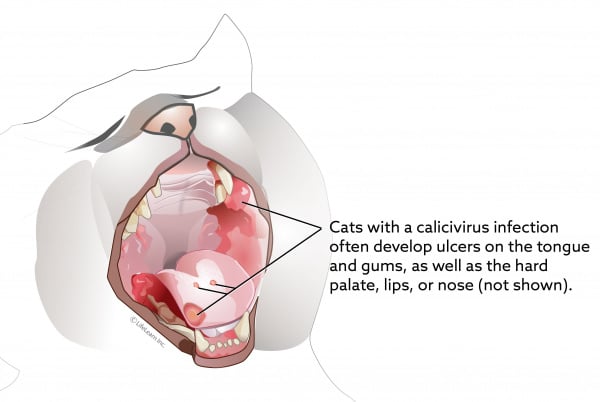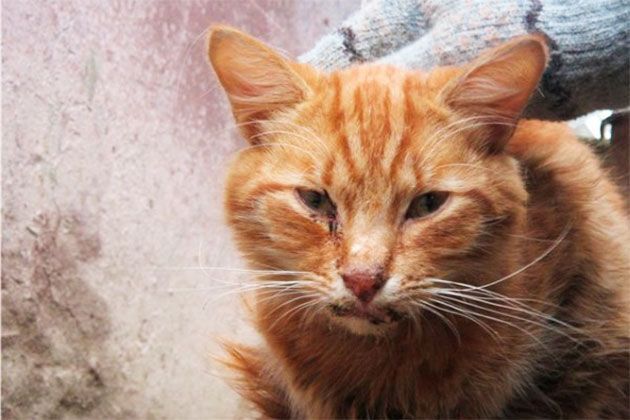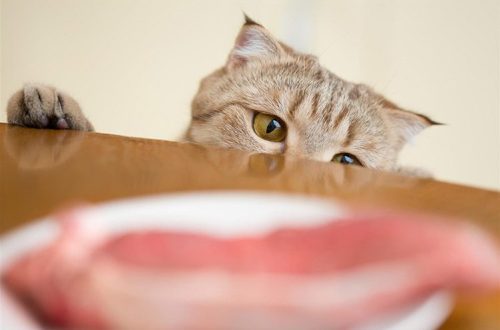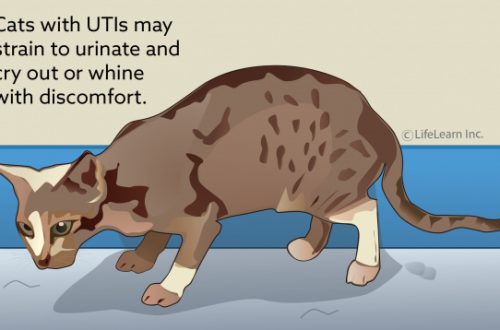
Feline calicivirus

Viral diseases are widespread. This is partly facilitated by the negligence of the owners, who believe that a cat living at home and not walking on the street does not need to be vaccinated. Vaccination is a must, as you can bring the virus on shoes and clothes from the street. The most common diseases are panleukopenia, herpesvirus, calicivirus. Let’s talk about the latter today. Feline calicivirus is a highly contagious disease of the respiratory system of a viral nature, usually affecting the respiratory system, with signs of damage to the upper respiratory tract, but also with calicivirus, cats can have ulcers in the mouth, on the tongue, can be on the nose, in severe cases pneumonia sometimes arthritis.
Transmission paths
Animals leading a crowded lifestyle are most susceptible: overexposure, shelters, nurseries. The virus is poorly preserved in the environment, dies in 3-10 days. Excreted mainly with saliva, nasal discharge. The route of infection is contact, through household items: bowls, trays, etc. Also, cats can get sick by direct contact (when sneezing, microparticles fly over a distance of more than a meter) or through the clothes of people caring for a cat. Having talked with an infected cat on the street, you can bring the virus on yourself to a domestic cat. In some cases, cats can excrete the virus into the environment for life, while some get sick and the virus completely disappears from the body.
Symptoms
Symptoms may be similar to other respiratory infections:
- Temperature increase.
- Lethargy and apathy.
- Decreased or complete lack of appetite.
- Sometimes there is diarrhea, which is replaced by constipation after two or three days.
- The appearance of painful ulcers in the oral cavity, on the lips, on the nose, mucous membranes of the prepuce and vagina.
- Bleeding from ulcers, putrid smell from the mouth, inflammation of the gums.
- Profuse salivation.
- Sneezing
- Scabs in the region of the nostrils, eyes.
- Lachrymation.
- In some cases, lameness is noted.
- Gingivostomatitis in cats.
- Eosinophilic granuloma complex.
- Chemical or thermal burn.
- Herpesvirus.
- Chlamydia.
- Neoplasia.
- Viral rhinotracheitis in cats.
- Bortedellosis.
The weaker the immune system, the more body systems will be drawn into the disease. Respiratory system – rhinitis (inflammation of the nasal mucosa), interstitial pneumonia (pneumonia) – dangerous, ulcers on the tip of the nose. Eye involvement and inflammation – acute serous conjunctivitis, lacrimation, but no keratitis (corneal inflammation) or corneal ulcers. Musculoskeletal system – acute arthritis (inflammation of the joints), lameness will appear. Gastrointestinal system – ulcers of the tongue (often), sometimes ulcers of the hard palate and lips; the intestines may also be affected, but without clinical signs (no diarrhea). Sometimes there are ulcers on the head and limbs, skin edema, accompanied by severe fever. The onset of calicivirus in both adult cats and kittens is sudden, food refusal, hyperthermia (the temperature rises to 40 degrees Celsius).
Treatment
Unfortunately, there is no specific treatment aimed at destroying the virus that causes calicivirus. Therapy is complex, aimed at eliminating symptoms and helping the body fight infection. Locally treated ulcers with healing drugs. Systemic antibiotic therapy is necessary to prevent the development of a secondary bacterial infection. Anti-inflammatory drugs in the presence of arthritis. Intravenous infusions of solutions for dehydration. Instillation of drops into the nose is ineffective, inhalations give more benefit, provided that the cat agrees to them. Eye discharge may require instillation of an antimicrobial.
- Treatment is carried out on an outpatient basis, except in cases of severe pneumonia. With pneumonia, treatment should become more aggressive, since the severity and danger of the disease increases several times. The danger of the disease for kittens is higher than for an adult cat, more attention should be paid to a kitten with calicivirus. Only complex treatment gives positive results.
Prevention
Since the disease is very contagious, it is necessary to carefully treat household items and rooms where the cat lives with disinfectant solutions. Newly arrived animals must be quarantined. Not only because of the risk of the incubation period of calicivirus, but also other infections. On average, isolation is required for a month. Important attention should be paid to preventive vaccination. The most common feline vaccines protect against calicivirus. Kittens need to be vaccinated from the age of two months, revaccination is carried out after 3-4 weeks, and then an adult cat is vaccinated every year. Females are vaccinated before mating. Isolation of newborn kittens from older kittens and adult cats until these kittens have been vaccinated and the vaccine has had its effect. Minimize stress factors as much as possible, avoid crowding of animals. Comply with zoohygienic standards for group keeping of animals, monitor the timely disinfection of dishes, premises, and care products.





